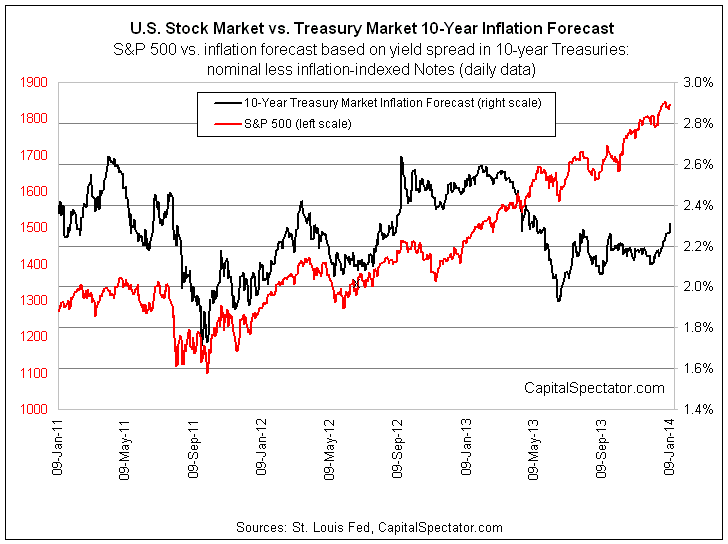The stock market is up sharply and inflation expectations have been stable in the low-2% range. That’s just what the monetary doctors have been prescribing and the markets have complied. This is the sweet spot that looked unlikely last spring. But a lot can happen when a determined central bank sticks to its plan for quantitative easing. The year ahead, however, will bring a new set of challenges. The first question: How long should the Fed let inflation expectations rise?
Consider how the numbers stack up so far. The S&P 500 has been rising persistently for the past year. Inflation expectations have only recently turned higher, although it's still early to worry about pricing pressures. For now, higher is still better. Indeed, the Fed’s preferred measure of inflation—core personal consumption expenditures—is rising at a muted 1.1% year-over-year rate through November, or well below the Fed’s 2% target. But the market’s outlook for inflation (the yield spread between nominal 10-year Note and its inflation-indexed counterpart) is increasing again, touching 2.31% in yesterday’s trading. That’s still within the range we’ve seen in recent years and so there’s nothing particularly troubling here. But if the economy is set to accelerate in 2014 (as it seems to be), we may see inflation expectations climb higher in the weeks ahead.
At what point will rising inflation expectations become worrisome? The answer, of course, depends on a number of factors, starting with the state of the economy. Meantime, the recent high for inflation expectations is roughly 2.6%. If and when the market prices the 10-year Treasury market above that level, the calculus for deciding the implications of higher inflation will be ripe for an attitude adjustment.
- English (UK)
- English (India)
- English (Canada)
- English (Australia)
- English (South Africa)
- English (Philippines)
- English (Nigeria)
- Deutsch
- Español (España)
- Español (México)
- Français
- Italiano
- Nederlands
- Português (Portugal)
- Polski
- Português (Brasil)
- Русский
- Türkçe
- العربية
- Ελληνικά
- Svenska
- Suomi
- עברית
- 日本語
- 한국어
- 简体中文
- 繁體中文
- Bahasa Indonesia
- Bahasa Melayu
- ไทย
- Tiếng Việt
- हिंदी
The Rebound In Stock Prices And Inflation Expectations
Published 01/12/2014, 12:13 AM
The Rebound In Stock Prices And Inflation Expectations
Latest comments
Loading next article…
Install Our App
Risk Disclosure: Trading in financial instruments and/or cryptocurrencies involves high risks including the risk of losing some, or all, of your investment amount, and may not be suitable for all investors. Prices of cryptocurrencies are extremely volatile and may be affected by external factors such as financial, regulatory or political events. Trading on margin increases the financial risks.
Before deciding to trade in financial instrument or cryptocurrencies you should be fully informed of the risks and costs associated with trading the financial markets, carefully consider your investment objectives, level of experience, and risk appetite, and seek professional advice where needed.
Fusion Media would like to remind you that the data contained in this website is not necessarily real-time nor accurate. The data and prices on the website are not necessarily provided by any market or exchange, but may be provided by market makers, and so prices may not be accurate and may differ from the actual price at any given market, meaning prices are indicative and not appropriate for trading purposes. Fusion Media and any provider of the data contained in this website will not accept liability for any loss or damage as a result of your trading, or your reliance on the information contained within this website.
It is prohibited to use, store, reproduce, display, modify, transmit or distribute the data contained in this website without the explicit prior written permission of Fusion Media and/or the data provider. All intellectual property rights are reserved by the providers and/or the exchange providing the data contained in this website.
Fusion Media may be compensated by the advertisers that appear on the website, based on your interaction with the advertisements or advertisers.
Before deciding to trade in financial instrument or cryptocurrencies you should be fully informed of the risks and costs associated with trading the financial markets, carefully consider your investment objectives, level of experience, and risk appetite, and seek professional advice where needed.
Fusion Media would like to remind you that the data contained in this website is not necessarily real-time nor accurate. The data and prices on the website are not necessarily provided by any market or exchange, but may be provided by market makers, and so prices may not be accurate and may differ from the actual price at any given market, meaning prices are indicative and not appropriate for trading purposes. Fusion Media and any provider of the data contained in this website will not accept liability for any loss or damage as a result of your trading, or your reliance on the information contained within this website.
It is prohibited to use, store, reproduce, display, modify, transmit or distribute the data contained in this website without the explicit prior written permission of Fusion Media and/or the data provider. All intellectual property rights are reserved by the providers and/or the exchange providing the data contained in this website.
Fusion Media may be compensated by the advertisers that appear on the website, based on your interaction with the advertisements or advertisers.
© 2007-2025 - Fusion Media Limited. All Rights Reserved.
